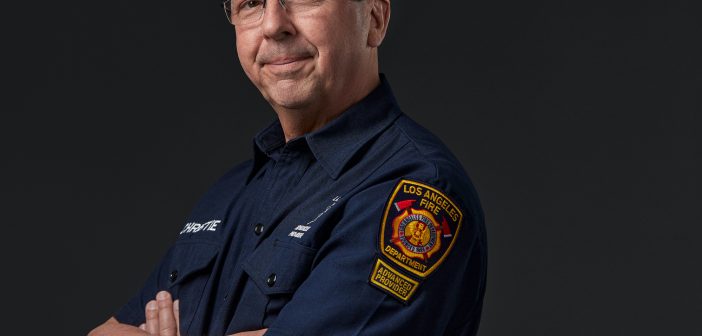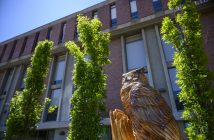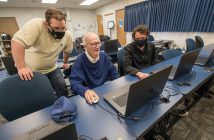By Bill Sweet
If you dig deep enough through YouTube, you can still find the video: A young hockey player lies prone on the ice, having suffered a skull fracture after colliding with another player, being worked on by an emergency team. You can’t quite make out the faces in the 20-year-old video, but if you look close enough, you can see Greg Christie ’80 at his calling: saving a life.
One of among the early generations of physician assistants, Christie, a biological studies and business administration major at Westfield State, has spent his career ascending from the examining room to the boardroom.
Over the past year he ditched the management level to join the Los Angeles Fire Department’s new triage program, a service that reduces the strain on ambulance services.
At Westfield State, “science resonated with me,” he says. He credits the support of his professors Joyce Eberlin, Irving Lepow, research advisor Barbara Taylor, and Peter Bulkley, history professor and mentor.
“The benefit of a small college is the connection I had with Dr. Eberlin and Dr. Lepow, who spent that extra time after class to talk with me,” he remembers. “For them, [teaching]was a passion, it wasn’t just a job. They were invested in my success.”
Upon graduation, medical school beckoned, but his bank account was reluctant to answer the call.
“Funding was running out when I received a letter from my sister, and she suggested becoming a physician assistant (PA),” he says.
The PA occupies a specific tier in healthcare, at a location just short of the physician. They can diagnose illness, oversee treatment plans, and prescribe medicine.
The first PAs came out of the Duke University Medical Center in the mid-1960s, with training modeled after the fast-track medical school that prepared much-needed field medics during World War II.
“They took the skill set of these guys coming back from Vietnam, medics who were saving lives, and put them back into the field to help the general population,” Christie says.
Christie enrolled in a 28-month associate degree program then offered through Case Western Reserve
and Cuyahoga Community College, based at Ohio’s Cleveland Clinic.
The Andover native spent the next decade and a half with the Harvard Community Health Plan, working nights and weekends in urgent care, rotating through the HMO’s sites. This experience, bolstered by night classes at Harvard Business School, led to a position at Harvard Vanguard Medical Associates in Somerville, where he became the practice’s chief of internal medicine, a relative rarity for a PA.
Throughout in his ascent to the management level, Christie never lost touch with directly providing emergency care. The most memorable instance came in 2003 when Joe Exter, goaltender for Merrimack College’s hockey team, collided with a Boston College player, fracturing his skull. Christie, then a sports medic for the team, stabilized him. Exter was in a coma for 10 days, and required physical therapy to speak and eat again, but survived.
Other higher positions followed, including a directorship in emergency medicine and services at Steward Healthcare in Boston, and vice president of operations for Marque Medical Urgent Care in California.
In 2020, he joined one of the Los Angeles Fire Department’s Advanced Provider Response Units, which were created in 2016 to address an escalating increase in the number of emergency calls. The units team firefighter/paramedics with civilian nurse practitioners and PAs to treat people in the field, an approach that’s been picked up in select cities throughout the Southwest, but none with as massive a task as Los Angeles.
“LA has four million people in 472 square miles, and the second-largest EMS in the country,” he says.
In contrast, a standard ambulance team assesses the situation and safely gets the patient to an ER, the APRU teams provide diagnoses and conduct tests on the scene, using Emergency Tele-Health and Navigation or ETHAN. They conduct evaluations at the point of the call to 911, cutting down on ambulance calls for physical complaints that aren’t life-threatening.
And this model works: nearly two-thirds of the calls handled by LAFD Tele-Health direct the patient to care rather than an ER visit.
He splits his time between working the control center, which receives about 2,000 calls per day, and supporting paramedic crews in the field.
And it’s exactly where he wants to be.
“I miss the executive suite, but I love problem-solving and building teams,” he says. “Working in a city is daunting, but I couldn’t dream of a better challenge and use of 30-plus years in health care.
“My dad always used to say to me, success without purpose is meaningless,” he continues. “What drew me into this was the purpose, not the position. Providing a service to a very diverse and needy population.”




